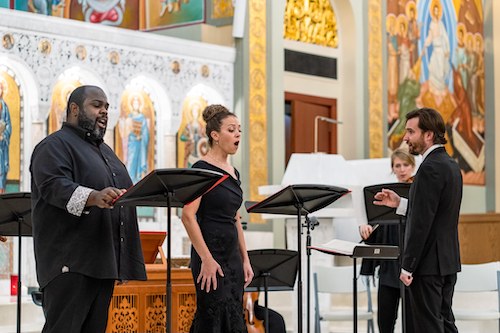Seraphic Fire returns live with outstanding Pergolesi

Giovanni Battista Pergolesi’s Stabat Mater was one of the most celebrated sacred works of the eighteenth century. Once standard repertoire, the score has been less frequently played since the later years of the twentieth century.
On Thursday night, Seraphic Fire revived this strikingly original creation at the recently renovated St. Sophia Greek Orthodox Cathedral in Miami. The performance marked the group’s first live concert in twenty months and a return to its musical roots.
In his opening comments, artistic director Patrick Dupré Quigley noted that the program commenced the ensemble’s “belated nineteenth season” and that the Pergolesi work had figured in Seraphic Fire’s very first season.
For this series of performances, Quigley is not fielding a complement of choral singers. Instead, two soloists—soprano Lauren Snouffer and countertenor Reginald Mobley—were supported by a five-member instrumental contingent.
Pergolesi’s setting of the Hymn to the Virgin Mary and her agony at witnessing the crucifixion of her son Jesus manages to fuse Italian operatic and liturgical traditions. Primarily an operatic composer best known for the opera buffa La Serva Padrona, Pergolesi died at age 26 of tuberculosis, his creative career lasting a mere six years. Despite his declining health, he accepted a commission from a confraternity in Naples to write a new setting of the Stabat Mater. Although he finished the score before his death, Pergolesi did not live to hear it performed. The early response to initial performances throughout Europe was highly enthusiastic and it is widely acknowledged as Pergolesi’s masterpiece. Bach greatly admired it and appropriated parts of the work for one of his cantatas.
Scored for soprano, alto voice and three strings with continuo, this unique work remains strikingly original and intensely dramatic. The dissonances in the opening duet are riveting and unique in eighteenth century music. Jesus’ scourging and death, Mary’s sorrow and tears all come vividly to life amid Pergolesi’s inspired melodic writing and instrumental invention. Bold in its fugal creativity, this is a uniquely moving liturgical score that proved a welcome return for Quigley and his forces.
With sure pacing by Quigley, the two vocalists were outstanding. Snouffer and Mobley fully realized the beauty, tension and throbbing theatricality of Pergolesi’s musical discourse.
Following the grave instrumental introduction, they brought precision and sterling musicianship to the singular harmonic structure of the initial duo. With vigorous string accents, Snouffer’s opulent middle register matched her strong top range in the aria “Cuius animam gementem” (Through her weeping soul). Mobley struck just the right note of solemnity while soaring in coloratura for “Fac ut portem Christi mortem” (Make me hear Christ’s death). The melding of the two singers’ timbres in the final duet and “Amen” was perfectly balanced and emotionally expressive.
Organist Aya Hamada and cellist Sarah Stone provided incisive, continuo work. Violinists Edson Scheid and Isabelle Seula Lee and violist Annie Garlid shaped the string lines with tonal warmth. With superb singing, strong and purposeful direction by Quigley and stylish instrumental articulation, the performance’s cumulative impact was deeply felt. A prolonged standing ovation followed the final bars.
The evening opened with Quigley’s arrangement of “America the Beautiful” (by composer Samuel Ward Newmark). Mobley’s pure, unforced sound and Snouffer’s exquisite high tones vanquished the cobwebs from this familiar patriotic ode. Quigley adroitly blended “My Country tis of Thee” and the “Battle Hymn of the Republic” into his instrumental writing.
Mobley offered a finely stylized traversal of “Taedet animam” by Cuban composer Esteban Salas y Castro. The noble melody of “O Malheureuse Iphigénie” from Gluck’s opera Iphigénie en Tauride was spun in silken tones and grandeur of line by Snouffer. Despite her light instrument, her voice filled the resonant sanctuary.
With Quigley taking a seat, the continuo duo of Hamada and Stone provided the robust accompaniment for Bach’s exhilarating duet “Wir eilen mit schwachen” from Cantata No. 78 “Jesu, der du meine Seele.” Snouffer and Mobley brought felicitous charm to this lovely confection.
Scheid offered an instrumental interlude with two caprices from The Art of the Violin by Pietro Locatelli. (Paganini clearly knew the Baroque composer’s opus and appropriated the thematic pattern of one of these cameos for one of his own 24 caprices.) Locatelli’s violin exercises are almost as technically demanding as Paganini’s, and Scheid’s vigorous bowing, control and solid intonation illuminated these devilish vignettes.
Even in reduced configuration, it was great to have Seraphic Fire back giving public performances. The revival of Pergolesi’s Stabat Mater was the kind of major event we have come to expect from Quigley and his artistic associates.
Seraphic Fire repeats the program 7:30 p.m. Friday at St. Philip’s Episcopal Church in Coral Gables; 7:30 p.m. Saturday at All Saints Episcopal Church in Fort Lauderdale; and 4 p.m. Sunday at St. Gregory’s Episcopal Church in Naples. The Coral Gables performance is sold out. seraphicfire.org
Posted in Performances
One Response to “Seraphic Fire returns live with outstanding Pergolesi”
Leave a Comment
Fri Nov 5, 2021
at 12:43 pm
1 Comment
Posted Dec 04, 2021 at 8:34 am by stephanie D cabell
Is there a link to Seraphic Fire’s performance of Pergolesi’s Stabat Mater with Reginald Mobley and Lauren Snouffer? I would love to watch it.